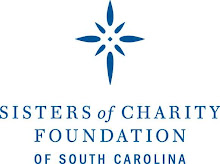The Sisters of Charity Foundation and the Columbia community lost a great person last week with the death of Rhett Wolfe. Rhett was one of the most positive people I have ever known. He always made the best out of every situation. Even in the worst of times, he would find something to smile about. I truly admired that about him. Rhett served this Foundation for many years. He was a founding member of the Board and began his first term in 1996.He actually was the only Board member to come back on the Board for another term after his full term expired. He was our Board Chair from 2003-2005 and served on virtually every committee that the Foundation had to offer. He was truly loved by our Board and staff.
Rhett, Sister Judith Ann Karam, Pat Littlejohn and I joined other South Carolina Foundation colleagues on a trip to Prague in 2004. We visited several Foundations and spoke to a group of local funders on finding ways to engage a community in philanthropy. Rhett made the trip so much fun. We toured the Country, ate good food and we laughed. Then we laughed some more. It was a memorable experience.
Rhett Wolfe touched my life in many ways and he was my friend. But hundreds, if not thousands of others could say the same thing. We are proud to have had him as part of the Sisters of Charity Foundation family for 14 of our 18 years. He was faithful, loyal and dedicated to our mission.
Even though Rhett had a tragic ending that took his life too soon, we were blessed to have known him for as long as we did. And frankly, I find it hard to feel sad when I think of him. Even after he is gone, he still makes me smile. That is the Rhett Wolfe I will always remember.
Tom Keith, President
Sisters of Charity Foundation of South Carolina







